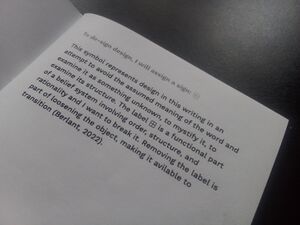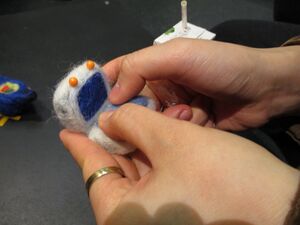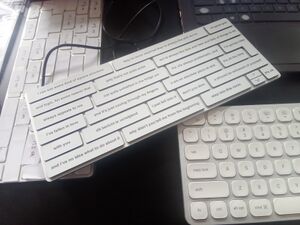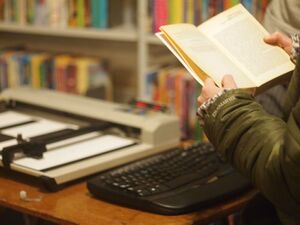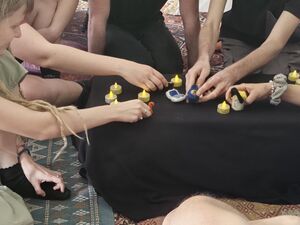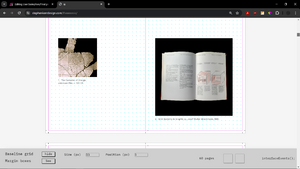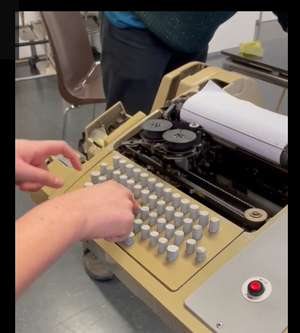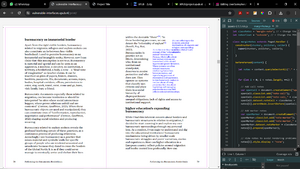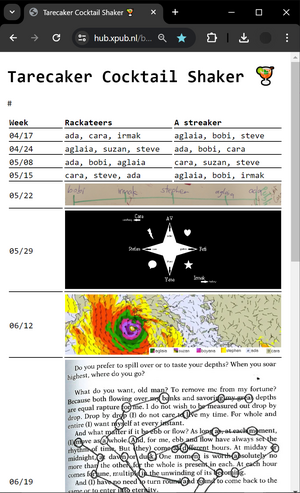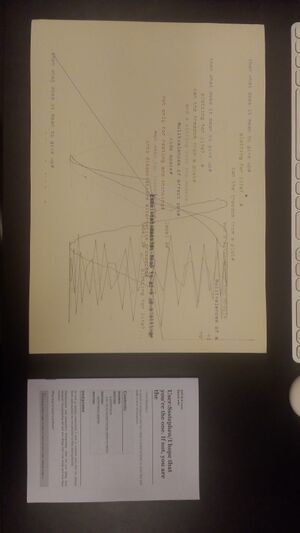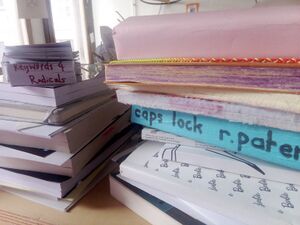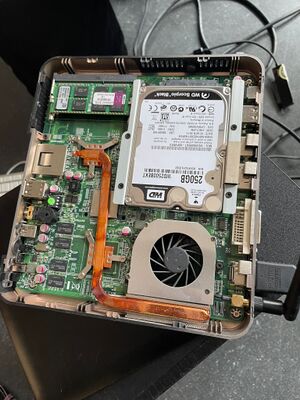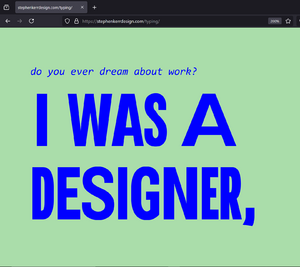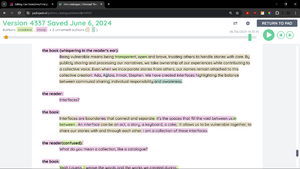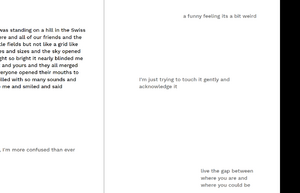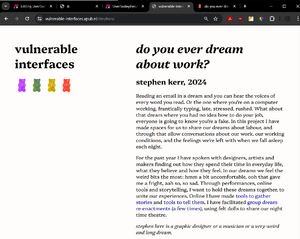User:Ssstephen/Final presentation
my thesis
As both a piece of research and writing, coherence was a challenge in my thesis. I pushed myself to create methodologies that are both innovative and challenging, while ending up with a format that is significant and coherent. All the while refusing definition. The methodologies included unusual interview questions, group interviews, autoethnographic data-gathering and a heaping pile of self reflection. The introduction of the thesis clearly articulates the intention of these approaches.
https://stephenkerrdesign.com/theeeeesis/
my final work and research
My final work is practice-led artistic research into the 21st century phenomenon of the graphic designer. I held graphic design in my hands using ethnography, toolmaking and performance as research methods. I examined how designers spend their time in everyday life, this designer, me, as well as you, what are we doing? What are our worldviews, belief systems, mythologies and ideologies?
https://vulnerable-interfaces.xpub.nl/stephen/
my plans for final publication and grad show
For the graduation show, Vulnerable Interfaces, I will contribute in two formats on the subject of people's dreams about work and labour. Firstly I will have an installation of a customised Apple Magic Keyboard and Apple 2022 Retina 5K iMac on which visitors can type to explore the dreams that have been shared with me throughout the year, mostly those of graphic designers. Secondly I will facilitate group re-enactments of work dreams as I have done several times this year, creating a space where people can share stories about their work and the emotions and struggles associated with them.
my contributions to the special issues
In the first special issue last year, I was already exploring some themes and techniques within the collaborative work that would find their way into my self-directed research later. Keyboards, pen-plotters and lasercutting paper as new tools to explore. Typing, reading and quoting as ways for people to interact with a work. At the Leeszaal event I brought a machine where people could write what they wanted to contribute to the publication, but sometimes the words of others came out instead.
my prototyping practice across the 2 years
In prototyping in second year I identified my subject matter of designers and their feelings, and formulated my research questions in a tangible way. The first time I tried out the felt doll re-enactments was during a prototyping session with Manetta, Ada and Irmak. By iterating on the performance at the public moment and AMRO, I had a chance to explore the direction I wanted the work to go.
my final work and research
It makes me cringe a little now but I have continued on a path of combining these areas that I work within. I'm not so much into the holistic Gesamtkunstwerk thing any more thankfully, but I am happy that the work I have made is a distinct area of research, relevant to other practitioners in the field (Ruben Pater, Silvio Lorusso), and asking it's own questions.
my reading/writing practice across the 2 years
There are so many things to read in the world and so much to say, and the list has just gotten longer through my time in xpub. But while writing the thesis, I learnt how to focus the inputs and outputs in developing research, synthesising relevant ideas into a creative project. All the thousands of words written and stripped away, and tangents that weren't weird enough, thanks for being patient with them Marloes :)
my thesis
Some parts of my thesis involved reading design theorists as you might comparatively read religious texts. What were or are the beliefs of the authors and their audiences? I analysed these texts outside their usual context and compared them to broader social narratives of order vs chaos, rationality and efficiency. I tried to make visible the functional, materialist narratives we have today, for example by talking about the spiritual beliefs of early modernists.
my final work and research
In my work this year, I experimented with ways of allowing people to tell stories that would at the same time be a piece of ethnographic research and be instantly shared as a publication or performance. For example a website where people can share and read stories of their dreams about work or the performances where people re-enacted these same dreams. As pieces of research these had hugely different impacts. The website is much more reliable and efficient at collecting stories of dreams, but the conversations that happen in the performances are to me far more successful and valuable.
my contributions to the special issues
In Special Issue 21 we unfolded the many cultural and technical layers that we found stratified in a particular machine, a TeleType Model 33, reading them as questions to our contemporary involvements with computing and with networks. It's just one example of how I've learnt here to question the world through its artefacts.
my plans for final publication and grad show
For the Vulnerable Interfaces publication, we are yet again using the paged.js web2print xpub-tastic git-book workflow. Using Julie Blanc's marginNotes.js plugin feels different because she showed it to me herself when she visited last year. Code is made by people and communities. Maybe when we resolve this issue of the overlapping margin notes we can send an updated version back to Julie, as it's a feature she has been interested in too. There is always an idea underneath a piece of software and I like how in open source communities like PrePostPrint these ideas are more clearly revealed and shared.
https://vulnerable-interfaces.xpub.nl/print/
my contributions to the special issues
Special issue XX was a complex and creative project which brought together some original combinations of media forms and collaboration methods. Using a git repository, we created a book and website in a seam-full process. We lumpily blended traditional publication roles: authors, editors, designers, readers, each emerging from different people and groups at different points in different forms. Using a distributed version control system as a technical tool reflected the social organisation that we ended up with: six confused and eager ducklings pushing and pulling, committed.
https://git.xpub.nl/XPUB/SI20/commits/branch/main
my final work and research
Bringing our work to AMRO (Art Meets Radical Openness) festival in Linz involved once again combining seperate projects and media into an effective and creative whole, literally under a single roof. It was an opportunity to test out my work in the context of other related research and art projects, and it was really nice to be able to talk about our work with practitioners with similar thematic interests from around the world.
my contributions to the special issues
Special Issue 21 involved experimenting with communal production contexts. It was an on-going publishing arrangement, constantly re-considered and escaping definition at every point in spacetime, a sort of Exquisite Corpse Network. It evaded naming, location, and explanation; the Briki, the Breadbrick, the Worm Blob. A plan to release weekly bricks was wattled by a shared understanding of time into something more complex in structure, less structured in complexity.
https://hub.xpub.nl/breadcube/breadbrick/tarecaker-cocktail-shaker/
my prototyping practice across the 2 years
Prototyping has helped me to understand the value in making experiments and tests to explore new forms and unforeseen challenges. This test print came from an arduino module I made for connecting eurorack modular synthesisers to a penplotter. I have learnt to be more flexible in my work practices in xpub its really valuable to me.
https://pzwiki.wdka.nl/mediadesign/User:Ssstephen
my reading/writing practice across the 2 years
It was great to have the time over these two years to read. In my first home in Rotterdam I had a little nook above the stairs that I could sit in an read and drink tea. The wiki has beed a great tool for reading for me, using the notation and reading methods learnt from Steve, Marloes and Simon I find my reading much more useful than it's been before. I now read critically and contextually: what I need to read, how I need to read it.
https://pzwiki.wdka.nl/mediadesign/User:Ssstephen/Reading
my prototyping practice across the 2 years
One great moment of practice and theory overlapping was when breadcube broke during special issue 21. While we were already having conversations about data, memory, and binary, this gave us a chance to look at and question how our own methods and server were functioning and designed.
my plans for final publication and grad show
A lot of my work in second year involved reflecting on my own practices, especially as a graphic designer. While I started the year with despair and disillusionment, after carefully critiqueing my position I am now instead filled with despondancy and destructive energy. Just kidding, but for sure there was not a magic happy ending to this story, instead my research helped me and other designers to express some dissatisfaction, angst, hope, love, boredom, rage and stress. I have aimed to position my work in the world of work and labour, but refusing to give up its affective human glow.
my reading/writing practice across the 2 years
I didn't have a writing practice before xpub. I'm much more confident talking about my work and the work of others, but also through learning about editing and other skills from methods, feel much more capable expressing, communicating and creating through the craft of writing in general. In second year, I became very conscious of the physical process of interacting with the computer through the keyboard. Words and ideas become and are expressed through my hands.
my thesis
The results of my thesis were always going to be blurry and gradiated, that was the intention. I have communicated this clearly at several points in the text, explaining why it was useful to be vague in the context of design where everything is made clear and communicable. Hemingway app tells me to be more bold and not use phrases like "we feel". In presenting the thesis as a series of fragments and conluding it with open letters and dreams, I have asked questions instead of answering them. "I'm more confused than ever" and I hope I have stood in front of the cliff with the reader and said with them "wow, big cliff, cool, a bit scary".
my plans for final publication and grad show
How do I present this mess to a general audience? How do I explain what I've been doing to my Mom when she comes to the grad show? Through writing about my work in special issues, prototyping, and methods class, I've learnt how to communicate my intention, context, process and perceived results. Joseph taught me to stop using big words and confusing sentences. In the vulnerable interfaces publication and show I will summarise what I have been doing for the year in performances, storytooling and written descriptions. And I will talk about it if you want to chat 27-30th June in slash gallery :)

